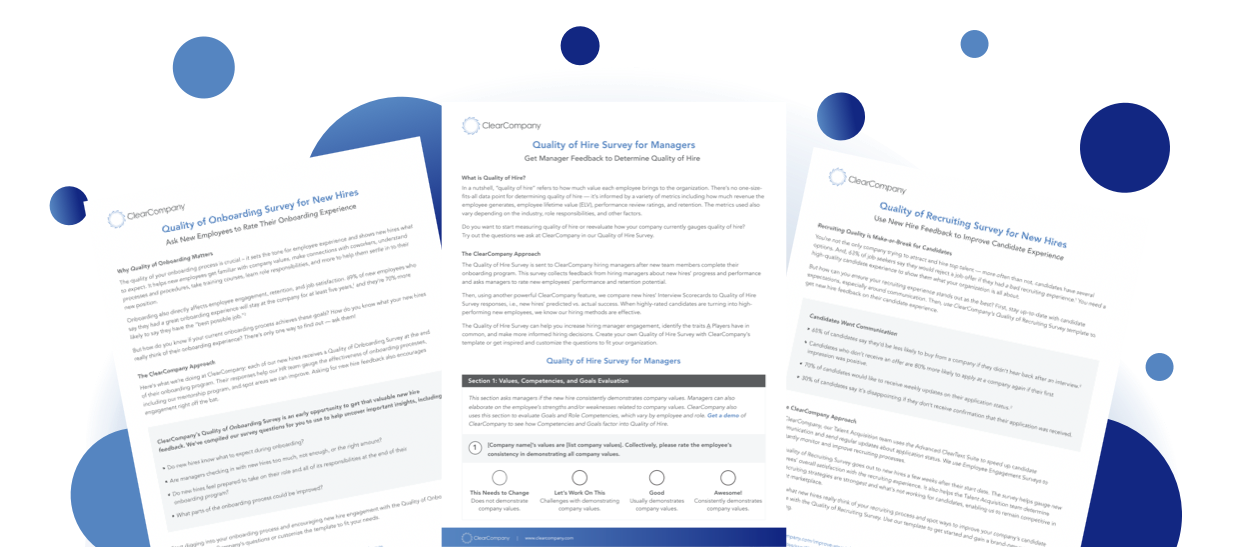In Part 1 of our series about employee one-on-ones, we talked about how these meetings help build trust and how they motivate growth and productivity. We talked about their critical role in employee engagement and how they’re a reliable tool to fight against current workplace disengagement trends, like the Great Resignation and quiet quitting. We also shared a few basics about these check-ins — how long they typically last and some of the topics that can be discussed.
But successful one-on-one meetings don’t just happen — you have to make them happen. Or more accurately, you and your managers have to make them happen. A five-minute chat won’t have the same effect as an intentional one-on-one check-in. So today, we’re going to share some more detailed tips on how to conduct one-on-ones that positively impact employees.
Employee one-on-ones can be impactful — but only if managers are bought in. Get 8 tips for how managers can conduct successful check-ins:Managers Make the Difference
We said it’s up to both you and your managers to make great one-on-ones happen, and that’s because of the evidence showing that great managers are the differentiator. According to Harvard Business Review, “the best managers recognize that 1:1s are not an add-on to their role—they are foundational to it.” Gallup research found that managers are responsible for 70% of the variance in engagement on their teams and that caring managers are a top indicator of engagement.
Some of your managers might think of employee one-on-ones as nonessential — nice to have, but the first thing to go when something else comes up. But, if they understand the impact these meetings have on employee engagement metrics and overall performance, they are far more likely to keep up with one-on-ones. You can also enable productive check-ins by giving managers the tips and tools they need to get them right.
Try these eight tips for conducting the most effective one-on-one meetings.
1. Add 1:1s to your schedule as recurring meetings.
Just like formal performance reviews, one-on-ones should take place on a regular basis. HBR recommends three cadences teams might adopt:
- Weekly meetings that last around 30 minutes
- Biweekly meetings lasting around 45 minutes to one hour
- A combination, where some team members meet with the manager weekly and others biweekly
The 30-minute weekly check-in was the most popular among employees and also led to the highest levels of engagement. Whatever schedule they choose, managers should add the meetings to their calendars as recurring events. That way, everyone knows when they’ll have a chance to talk and there are fewer interruptions throughout the week.
Managers should avoid canceling last minute or showing up late to one-on-ones, which sends the message to employees that these meetings aren’t a priority. Regular check-ins show employees their managers care about their success at work and can lead to higher engagement.
2. Conduct 1:1s face-to-face.
While most work communication takes place via emails or instant messages, one-on-ones are meant to establish a more personal connection between employees and managers. That means employee check-ins should be face-to-face — even if your employees are fully or partially remote. If the team is hybrid, managers should aim to hold these meetings in person. If the company or individual team members are fully remote, one-on-ones should take place via video chat.
Face-to-face conversations are important because while one-on-ones are about getting status updates and giving constructive feedback, they’re also about building a strong bond between employees and their managers. That’s much harder to create, especially with remote teams, if managers are not speaking with their employees face-to-face.
1:1 Tip: If your company is fully remote, make sure managers have access to video conferencing tools, one-on-one or performance management software, and other software necessary for conducting remote check-ins.3. Arrive prepared.
Benjamin Franklin famously said, “By failing to prepare, you are preparing to fail,” and his words certainly apply to one-on-ones. HBR’s research showed that preparing a meeting agenda was a strong indicator that the one-on-one would be beneficial. The publication also found that when employees and managers collaborated on agenda items, the check-ins were even more highly rated.
While it’s okay to create an agenda at the start of a one-on-one, it’s more helpful if each participant jots down a few discussion points to bring to the meeting. Even better? Sharing those discussion points before the check-in. Regardless, getting employees involved in creating the agenda ensures that managers don’t take over the meetings and that employees get to address their items.
Creating an agenda doesn’t have to be complicated, especially if you use performance management software that supports one-on-one meetings. The software gives managers and employees access to a collaborative, cloud-based space to create an agenda, give updates, and take notes that can be kept private or shared.
“One-on-ones are one of the most important productivity tools you have as a manager. They are where you can ask strategic questions such as, are we focused on the right things? And from a rapport point of view, they are how you show employees that you value them and care about them.”
- Elizabeth Grace Saunders, author and founder of Real Life E Time Coaching & Training
4. Stay present and positive.
It’s up to managers to set the tone for employee check-ins and keep them positive. They shouldn’t be stressful or seem like a chore managers have to get through. Encourage managers to bring optimistic, upbeat energy into their one-on-ones. One way managers can do this is by kicking off weekly meetings by celebrating a win or expressing gratitude for the employee’s recent contributions.
Managers should also be present during one-on-ones, without interruptions from email notifications or colleagues stopping by their office. They shouldn’t check email or respond to Slack messages, either. Rather, managers should be actively listening, paying close attention to what employees say, and thinking before responding.
1:1 Tip: HBR suggests managers listen 50-90% of the time during one-on-ones.5. Make 1:1s personal.
We’ve talked about how weekly one-on-ones help build relationships — especially if your managers ask employees how they’re doing. These check-ins are an opportunity for managers to get to know their employees and build trust. Managers can also ask open-ended questions about employees’ personal and professional development goals. This helps them get to know each other more and gives managers insight into how they can help employees reach those goals.
Managers can even promote engagement by asking the right questions, like how employees feel about their work-life balance and what managers can do to motivate them. They can also build that connection by asking employees about their lives outside of work — their families, interests, and big life events — and sharing about their own. Getting more personally acquainted helps create trust and makes it easier for employees to approach managers with questions, problems, and ideas.
Managers can make employee one-on-ones more effective by getting to know them on a personal level. Get more tips for how to conduct successful one-on-ones:Weekly check-ins give managers the chance to coach employees, offering feedback and helping them work through any challenges or roadblocks holding them back. They can ask employees to bring their own plan of action to the meeting and then work together to find a solution. This way, employees first apply their own problem-solving skills to the issue. Managers can get a better idea of where employees are struggling and offer specific advice and resources to help out.
1:1 Tip: Managers can ask specific questions to ensure employees aren’t holding back when asking for help, like “What do you need from me to do your best work?”7. Take notes.
Taking notes during one-on-ones is a good tool not only to remember what was discussed but also to create a record of past conversations. Managers and employees can reference them to prepare for future meetings. Just like with employee performance reviews, an archive of these weekly chats supports future decisions about promotions, growth opportunities, or performance improvement plans (PIPs).
If you’re using software to power your one-on-ones, digital records make it easier to keep track of and look over past notes. Managers and employees can use their workspace to share notes as well as take their own private notes.
1:1 Tip: Managers can look back at past notes to hold themselves accountable for conducting useful one-on-one conversations.8. Leave with action items.
One-on-ones should end with a plan of action for both managers and employees. Setting expectations makes it more likely that they’ll be met and makes it easier to follow up on tasks. Ending with intention reduces the chances someone will drop the ball or miss any loose ends.
Before ending the call or chat, summarize the next steps for each person. Managers should clarify what the employee should accomplish by the next meeting and where the manager needs to provide support. With performance management software, they can add these action items to a shared note and even add short updates throughout the week, enabling a more productive discussion during the one-on-one.
You can empower managers to hold more productive, efficient one-on-ones with ClearCompany’s new 1:1 Workspaces feature. Available in our robust Performance Management System, 1:1 Workspaces increases performance insight, encourages engagement, and equips managers and employees with the tools they need to do their best at work.
Experience the newest addition to the ClearCompany Performance Management Suite, 1:1 Workspaces. Sign up for a personalized demo with ClearCompany product experts today.



